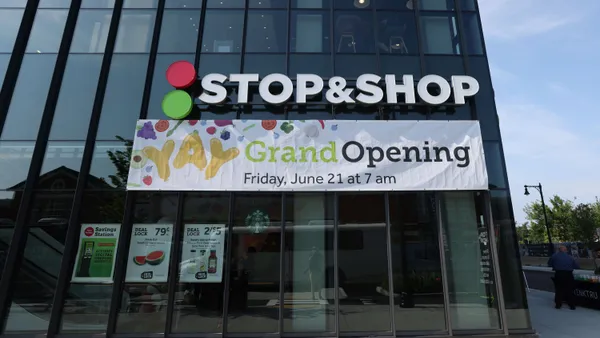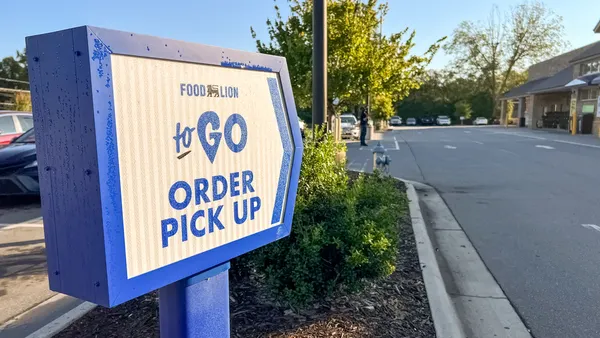Independent grocery stores face a number of challenges today, from limited labor and financial resources to e-commerce competition from retail giants. At the same time, independent grocers often have the ability to stand out with a unique in-store experience, community-oriented customer service and a level of flexibility that traditional supermarket chains can't replicate.
According to Nielsen’s 2018 National Grocery Shoppers Survey conducted in partnership with the National Grocers Association (NGA), about 21% of grocery dollars go to independent grocery stores. While that may be a small percentage of the overall grocery market, among people who classify themselves as independent shoppers, Nielsen found that loyal independent grocery shoppers spend more than 40% more on groceries than the average shopper.
Today, NGA represents 7,000 storefronts in every U.S. state, acting as the voice for independents in a competitive industry. Grocery Dive spoke with NGA president and CEO Peter Larkin, who will be retiring at the end of the year, to learn more about what’s next for independent operators.
This interview has been edited for length and clarity.
Grocery Dive: How are independent grocery operators tackling the challenge of e-commerce in today’s industry?
Larkin: They are evaluating what their customers want in the communities that they serve. Many of them are exploring what their e-commerce offering will look like. Some of them are doing e-commerce with delivery, some are doing e-commerce with click-and-collect. Others are opting to go with third-party companies that will actually do the shopping in store, like Instacart, and so there’s a third party between the retailer and their customer. So we’re seeing it all. Some of our members have been doing e-commerce and delivery and click-and-collect for over a decade. Others are just exploring what they want to do now that it’s becoming more prevalent.
"Some of our members have been doing e-commerce and delivery and click-and-collect for over a decade. Others are just exploring what they want to do now that it’s becoming more prevalent."

Peter Larkin
President & CEO, National Grocers Association
Grocery Dive: Can you offer an example of a grocery company that you think is innovating in the space today, and what they’re doing to stand out?
Larkin: I think winners come in all shapes and sizes — small format, large format, price impact, gourmet/specialty, organic/natural and traditional food and drug supermarkets. The one thing that they all have in common is that they know their community and their customers, and they deliver what their customers want. There is no one formula for what a winner looks like.
I hesitate to name names, but let me go through some of our companies. Sendik’s, Niemann Foods, Lowe’s in Texas and many others are experimenting with smaller formats. Roche Bros. in Massachusetts does the same. We have many of our retailers that, even though they have traditional grocery stores, they are running price impact stores: Lowe’s [Savers] Cost Plus, Save-A-Lot food stores, Grocery Outlet. These are limited assortment, but very, very successful and popular with customers.
In gourmet/specialty, we’ve got Newport Avenue Market in Oregon. We’ve got Mollie Stone’s in California, Gelson’s in California and Dorothy Lane Market in Ohio. We have many traditional food and drug supermarkets, but in a lot of ways they’re different from one market to the next. Trig’s supermarkets’ owner Trig Solberg just won our Thomas K. Zaucha Entrepreneurial Excellence Award. He operates eight stores in far north Wisconsin and they’re beautiful stores, but they’re what I’d call a traditional food store — fairly large, 40,000 square feet. But you cannot walk into that store without feeling the local way it is marketed and merchandised. They have their own smoked meats, their own specialty products throughout the store that only they carry and they make. So there is not a one-size-fits-all. There are a lot of good operators out there.
Grocery Dive: What does the future look like for independent grocers, from the small, family-owned stores to the larger chains?
Larkin: Well I’m bullish. I think the future is very positive. I’m optimistic for a lot of reasons. They support their local community. They know their customers, they’re flexible, they can make decisions very easily. They can turn on a dime. They can do things much quicker, faster because they control their own destiny as opposed to some of the larger chain operations that have a harder time making those kinds of quick decisions.
Competition is going to continue to be tough. We have other supermarkets, club stores, mass merchants, price impact, discount, natural/organic, online meal kit subscriptions, drug stores, C-stores, you name it. You can even buy food in a Home Depot these days. But our members are better able to provide consumers with what they want, when they want it.
We may lose a few independents that don’t have family members to take over their stores, but I believe a lot of those stores that may be looking for new owners — other independents will see an opportunity and buy them up, we’ve already seen that. While some will fall out, others will grow and become stronger.
Grocery Dive: What do you think are the keys for independent grocers thrive in the next five years?
Larkin: These are businesses that have been in families for decades and decades. They have a true sense of serving their communities. They’re not just out to make a buck. You can’t place a real value on that. It’s almost priceless, and our members do that in communities all over the U.S. Because of that, they’re able to have a better understanding of what customers want. That’s really what makes them successful. They provide local products, they support their local community organizations and will continue to do so as long as they’re in business. They may change the product mix, they may update their stores, they may try to differentiate who they are in the community …, but what it boils down to is just making sure that the people they have served for decades still value them and want to spend their food dollars in their stores.
Grocery Dive: National Grocers Association focuses a lot of its efforts on lobbying. What are the major legislative and policy challenges that independent grocers are facing right now?
Larkin: When the tax reform bill was passed in the last Congress, there was an inadvertent drafting error that disallowed our members from taking advantage of bonus depreciation, quicker depreciation when they do a remodel and put in new equipment and fixtures. We will continue to work to correct that very technical error so that our members that are investing in their stores and their warehouses can take advantage of that particular tax benefit, which is available to many industries — just not ours as a result of this glitch. [Update: Senators Pat Toomey and Doug Jones introduced a bill on March 14 that would amend the so-called "retail glitch."]
"I’m bullish. I think the future is very positive. I’m optimistic for a lot of reasons."

Peter Larkin
President & CEO, National Grocers Assoication
Another issue that we have been active [in] for many years, and will continue to be, is efforts to help lower costs of payments that we accept at the front end of stores. It’s very expensive for us to accept credit cards, expensive but less so for debit, and importantly, the issuing banks and Mastercard and Visa control the rules by which we must play if we are going to accept those payments. We have little input into those rules and regulations. They are imposed upon us. So a lot of our efforts in the next Congress will be to look and see if we can get people to understand that we need to have a seat at the table, we need to be able to participate in the decision-making process.
We are also a major participant in delivering SNAP benefits to consumers throughout the U.S. There has been and will continue to be debate and legislation on just how the SNAP program is going to work. It’s a perennial issue for us in terms of working with Congress to make sure that the SNAP program continues to run efficiently and effectively.
One of the things that we’ll be involved in this year as a result of the farm bill that passed last year was a new, more heavily funded program that is designed to provide more fruits and vegetables to SNAP recipients. It’s called Double Up Food Bucks. We will work with USDA and other stakeholders to implement that program more widely than it has been done in the past.
Grocery Dive: What’s your take on the latest news about Amazon opening its own grocery chain? What type of challenge does this pose to independents?
Larkin: Yes, I have thoughts. Do I have any real knowledge or insight? No. Nobody really knows what Jeff Bezos and his team are up to. There’s a lot of speculation that the key to Amazon’s future in the grocery business is more of a combination of online and brick-and-mortar, beyond what they can achieve with just the Whole Foods format. But again, who knows. What shape that would take is anyone’s guess. Is it more Amazon Go stores? Is it a smaller format but with full grocery, but not necessarily upscale, natural and organic? Or is it a large format, more like a traditional grocer but differentiated by Amazon private label products or some new technology play that none of us understand? The answer is, who knows. But it’s going to be interesting to watch.
Grocery Dive: You’ve had a remarkable career and made a significant impact in the grocery industry, especially through your work at NGA. What’s your biggest takeaway, and what are your plans for retirement?
Larkin: I’m very fortunate to have the opportunity to serve our members and the industry here at NGA for nearly 10 years. Dating back my whole career, I’m about to culminate 43 years, and most of it has been in the grocery business.
I will continue to try to stay involved in the industry in a different capacity. Most likely I will advise companies that want to fully understand the supermarket business and particularly the independent channel. I already serve on some outside boards and I would like to continue doing that. I would imagine I’ll do some consulting, but at this point in my career I need a different pace than the rather hectic 365-days-a-year focus that this job requires.
I’m a very lucky man to have been in the industry and work with the people I have worked with over the years, and that goes double for the folks here at NGA. It’s been an honor.
Grocery Dive: And a fun one, for good measure. How do you grocery shop, and what products do you like to buy most?
Larkin: I’m not much of an online shopper, my wife does more of that than I do. I enjoy actually being in a supermarket and I think it’s sort of an occupational hazard if you will, but I like to see new products. I like to see and smell and taste and actually explore new opportunities that can only be found by actually going in a brick-and-mortar store. I actually like to cook. I may not have any business trying to cook or prepare a meal because I’m not a chef, but that hasn’t stopped me yet. I like to go in and source the products I need from a particular recipe and see if I can make it work.
Food to me is more about than sustaining life — it’s about the experience and fun and creativity that comes, which is another cool part about being a part of this industry.













